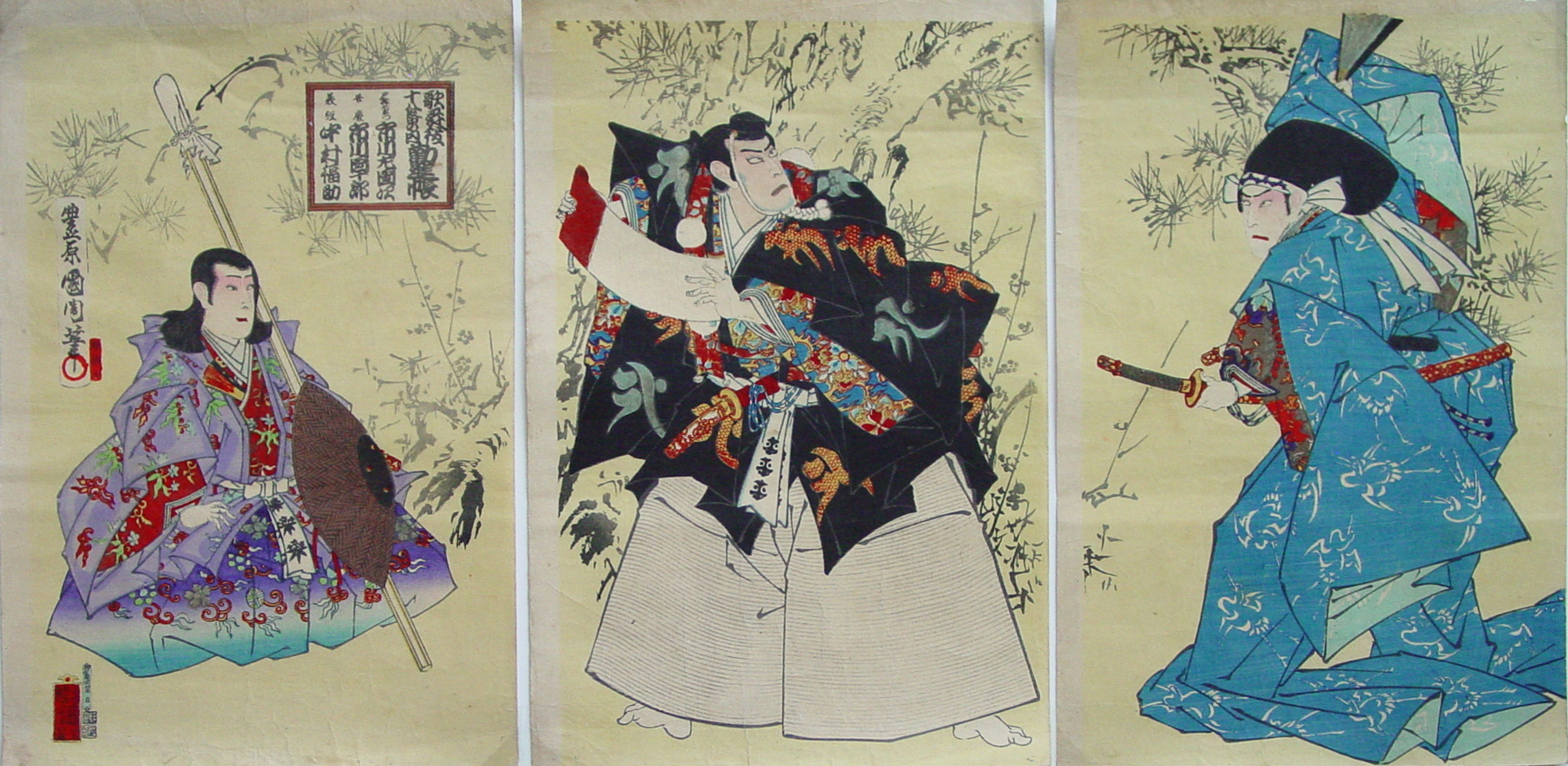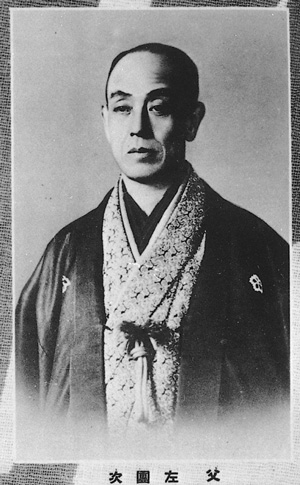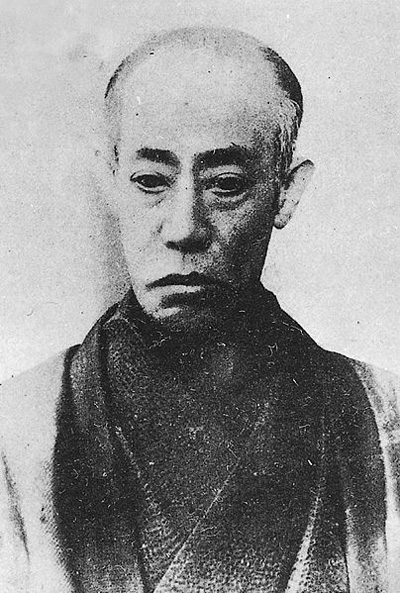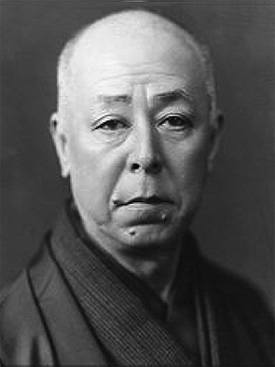About This Print
Thethree actors (R to L) Ichikawa Sadanji playing the role of Togachi Saemon, Ichikawa Danjūrō IX in the role of Benkei and Nakamura Fukusuke IV in the role of Yoshitune in the play The Subscription List* (Kanjinchō), performed at Tokyo's Shintomiza theatre.* sometimes translated as The Contributor's List and The Subscription Record
A Performance for the Emperor
Source: Kabuki Plays on Stage: Restoration and Reform, 1872-1905, James R. Brandon, Samuel L. Leiter, University of Hawaii Press, 2003, p. 4.
In April 1887 (two months before this print was issued), in an important event for kabuki, four days of performances were arranged for the imperial family, marking the recognition of kabuki’s restored social status. The actors performed al fresco on the grounds of the residence of Foreign Minister Inoue, in Tokyo’s Azabu district. The emperor attended the first day’s peformance of The Subscription List (Kanjinchō), with the actors Danjūrō IX, Ichikawa Sadanji I and Nakamura Fukusuke IV, who are pictured in this print in a performance that occurred several months later.
The Play "Kanjinchō"
Source: Naritaya Official Website http://www.naritaya.jp/english/show/detail.php?no=2010010220100126124934
Kanjinchō is based on the No play Ataka and is classed as a jidaimono (history) play and a matsubamemono. It was the first of the group of plays chosen by Ichikawa Danjūrō VII as one of the Kabuki Juhachiban – the "Eighteen Favourite Plays" which are representative of the ie no gei or "family art" of the Danjūrō acting line.
Set in the late twelfth century, the play depicts an episode from the life of the general Minamoto Yoshitsune. Accompanied by a small group of trusted retainers, he is escaping from his jealous older half-brother, the shogun Yoritomo. Yoshitsune's right-hand man is the warrior priest Benkei and it is he who suggests the retainers disguise themselves as mountain priests called yamabushi and Yoshitsune as their porter. Hearing rumours of this, Yoritomo has ordered barriers gates set up in order to stop and question all such yamabushi.
On their way north, Yoshitsune and his group reach the barrier at Ataka and are halted by the guard Togashi and his men. Hoping to pass through without incident, Benkei claims that they are collecting funds for the rebuilding of Todaiji temple which has recently burned down. He is challenged by Togashi to produce and read out the list of subscribers (the kanjincho of the play's title) that all fund raisers were bound to possess. Not having such a kanjincho, Benkei decides on the desperate measure of improvising the florid and pious exhortation from an empty scroll. While he is reading Togashi edges forward, trying to catch a glimpse of the scroll. Benkei catches him and the two of them pose dramatically with Benkei holding the scroll tight to his body so that Togashi cannot see it. Whether or not Togashi has seen the empty scroll and knows that Benkei is bluffing is one of the play's great talking points. He ends with the Fudo mie, a pose copying the iconography of the Buddhist deity Fudo-Myoo, the guardian protector of the yamabushi.
Still dubious, Togashi interrogates Benkei about the complicated symbolism of the yamabushi costume and this fierce verbal exchange, called the yamabushi mondo, famous for its escalating pace and tension, is another highlight of the play. Benkei concludes with the defiant Genroku mie pose.
Benkei's knowledge is impressive and Togashi decides to allow them to pass. One of his soldiers, however, points out the figure of the porter who, they claim, resembles Yoshitsune. To allay their suspicions, Benkei is forced to beat Yoshitsune with his staff as though punishing the porter for lagging behind and drawing attention to himself. Togashi is now certain that this group is indeed Yoshitsune and his men but, deeply impressed by Benkei's desperate act of loyalty, he decides to allow them through the barrier, even though he knows he must pay for this later with his own life.
Having passed safely and now a short distance from the barrier, Yoshitsune resumes his rightful position as lord of his group. As beating one's lord was an act of grave disloyalty Benkei sheds tears for the first time in his life, but Yoshitsune forgives him in a moving display of affection between lord and retainer.
Suddenly Togashi reappears. Claiming to feel sorry that he treated them so badly at the barrier, he offers Benkei some sake which is eagerly accepted. After drinking copious amounts, Benkei entertains them with the ennen no mai – the "dance of longevity." While the lyrics tell of an ideal landscape where the power of nature eternally reigns, the dance begins with slow, circular movements and gradually increasing in speed and excitement. During the dance, Benkei takes his chance and discreetly signals for his group to leave. They hasten on their way as Benkei concludes his dance. Benkei bids Togashi a moving farewell and the curtain is closed. Alone on the hanamichi, Benkei feels relieved and elated. He then joyfully bounds off to catch his master in the famous dramatic and stylised "flying exit" known as the tobi roppo.
The principal characters are:1
Togashi - barrier keeper
Yoshitune - younger brother of the shogun Yoritomo and disguised as a porter
Benkei - warrior priest and Yoshtune's loyal follower and inseparable companion, disguised as the leader of a band of yamabushi
Kamei, Kataoka, Suruga and Hitachibo: Retainers of Yoshitune, also disguised as yamabushi
Gunnai, Gennai and Heinai - soldiers of Togashi
1 The Kabuki Theatre of Japan, A. C. Scott, George Allen & Unwin Ltd,1955, p. 244.
The Actors Pictured
National Diet Library, Japan | Ichikawa Sadanji I 市川 左団次 (28 October 1842 ~ 7 August 1904) Source: Kabuki 21 website http://www.kabuki21.com/sadanji1.php Stage names: Ichikawa Sadanji I, Ichikawa Masuwaka, Ichikawa Koyone I, Ichikawa Tatsuzō Other name: Ichikawa Shōchō I Ichikawa Sadanji I belonged to the triumvirat of stars who dominated the Kabuki world during the Meiji era (the two others were Ichikawa Danjūrō IX and Onoe Kikugorō V). He was the leading actor of many shinkabuki dramas and worked on scripts written by authors who did not belong to the Kabuki world, like Matsui Shōō, or adapted contemporary popular novels, like Kōda Rohan's "Hige Otoko". His two most successful roles were Marubashi Chūya and Baba Saburobei in "Keian Taiheiki" and "Ōsakazuki". "At first he was a poor actor, and gave no sign of a promising career. Mokuami, the playwright, assisted him greatly by providing him with new plays and furnishing him with advice, and so great was his advancement that he was able to hold his own with Danjūrō and Kikugorō" (Zoë Kincaid in Kabuki, the Popular Stage of Japan) |
National Diet Library, Japan | Ichikawa Danjūrō IX (1838 ~ 13 September 1903) Source: Kabuki 21 website http://www.kabuki21.com/danjuro9.php Stage names: Ichikawa Danjūrō IX, Kawarazaki Sanshō, Kawarazaki Gonnosuke VII, Kawarazaki Gonjūrō I, Kawarazaki Chōjūrō III Other name: Ichikawa Jukai II Ichikawa Danjūrō IX belonged to the triumvirate of stars who dominated the Kabuki world during the Meiji era. (The two others were Onoe Kikugorō V and Ichikawa Sadanji I.) He spent lots of time and energy pioneering a new genre called katsureki but the Tokyo audience was more receptive to his amazing performances in the great roles of Kabuki like Ōboshi Yuranosuke ("Kanadehon Chūshingura"), Kumagai Jirō Naozane ("Kumagai Jin'ya"), Sukeroku ("Sukeroku Yukari no Edo Zakura") or Benkei ("Kanjinchō")."Ichikawa Danjūrō, the ninth, was the torch-bearer of Kabuki during the long reign of the Emperor Mutsuhito, known as the Meiji era, which endured for forty-five years ( 1868-1912). Danjūrō, the ninth, was the bridge that spanned the sudden gulf which yawned between the traditional past and the uncertain and changing modern world. He may be regarded as the saviour of Kabuki during a period when it might have suffered shipwreck, had there not been a man of genius at the helm to guide the craft through the troubled waters." (Zoë Kincaid in "Kabuki, the Popular Stage of Japan") |
wikipedia | Nakamura Fukusuke IV (Narikomaya) (9 December 1865 ~ 12 September 1940) Source: Kabuki 21 website http://www.kabuki21.com/fukusuke.php The actor Nakamura Utaemon V held the name of Nakamura Fukusuke IV from May 1881 to April 1901. He made his first stage appearance in August 1876 and became one of the best onnagata actors of the first half of the twentieth century. |
Print Details
| IHL Catalog | #398 |
| Title (Description) | The actors (R to L) Ichikawa Sadanji (I), Ichikawa Danjūrō (IX) and Nakamura Fukusuke (IV) in the play The Subscription List* (Kanjinchō 勧進帳). Transcription of title cartouche: 「歌舞伎十八番の内勧進帳」 「戸樫左衛門 市川左団次」 「弁慶 市川団十郎」 「義経 中村福助」 |
| Artist | Toyohara Kunichika (1835–1900) |
| Signature | Toyohara Kunichika hitsu with toshidama seal |
| Seal | none |
| Publication Date | June 3, 1887 |
| Publisher |  |
| Carver |  |
| Impression | excellent |
| Colors | excellent |
| Condition | good- full-size, unbacked, light wrinkling and minor soiling |
| Genre | ukiyo-e; nigao-e; yakusha-e |
| Miscellaneous | |
| Format | vertical oban triptych |
| H x W Paper | 14 5/8 x 9 7/8 in. (37.1 x 25.1 cm) each sheet |
| Literature | |
| Collections This Print | Tokyo Metropolitan Library N017-008 (01,02,03); Ritsumeikan University, Japan shiUYa006; The Tsubouchi Memorial Theatre Museum of Waseda University 100-2809,2810, 2811 |





